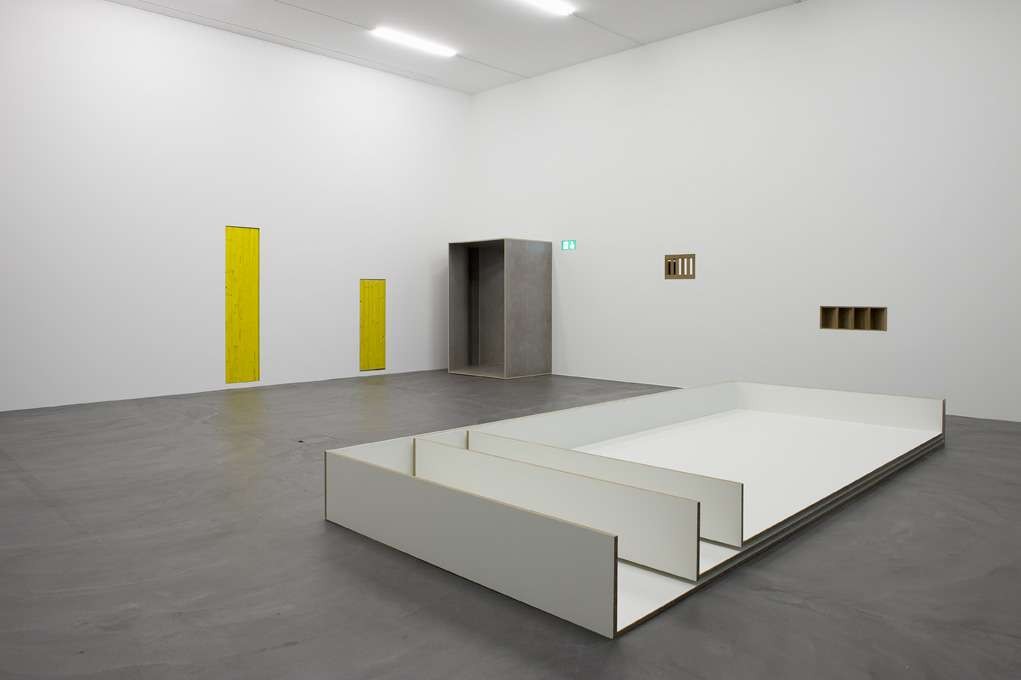Gabriel Sierra
Before Present
21 Nov 2015 - 07 Feb 2016
GABRIEL SIERRA
Before Present
21 November 2015 - 7 February 2016
We are almost constantly surrounded by architecture, but we barely perceive it. Yet it has a major impact on our thought and actions — sometimes obviously, but usually unconsciously. The Colombian artist Gabriel Sierra is interested in precisely this psychological dimension of architecture. He aims to create an experiment that explores the intricate relation in between reality and perception. After all, built spaces are repositories for ideas, fears, and convictions; they are full of ambitions, traces, and future experiences, and possess multiple layers of time. Hardly any other experience demonstrates this as strikingly as déjà-vu, when we witness a moment as if it had already occurred. During a moment of déjà-vu, the present is transported backward in time; in it, the past, the future, and the present merge into a magical second that is both euphoric and unsettling. Sierra’s exhibition at Kunsthalle Zürich is dedicated to this unfathomable and uncanny Before Present.
To recreate this condition, the artist repeats the same exhibition three times in separate spaces.
In the entrance of the exhibition and in a small area behind the exhibition space the artist has placed lights, intentionally at the height of the eyes of the viewer to erase the images of the retina before entering and after leaving the exhibition. The intensity of the light will be regu-
lated in relation to the moon phases. Specially created passageways transport us into three different time zones: in one, time lags behind, while in another it runs ahead, and in the third it seems to be correct. This structures allow to experience the exhibition; the exhibition as a
concept or idea, a situation per-se, a physic and psychological context. In the specially constructed exhibition spaces we encounter recurring objects and constructions lodged in the walls (like a combination of vernacular windows and ventilation ducts) as if they were being
absorbed into them.
Minor differences become apparent, since, as we know, reality is imperfect, just like memory. It deceives us and we deceive it, but as with déjà-vu it is not always clear which came first. Does deception come before reality, or is reality the basis of all deception? Here our thoughts begin to turn in on themselves, and for a moment time seems to stop. Yet this confusion does not merely serve to deceive, but invites us to see things in a new light. Sierra’s spatial arrange- ments are always also critical examinations of place, the language of material and elements that create the architecture, its power, and its lack of poetry.
Sierra’s interventions may appear sparing and simple, but their precision is imbued with a sense of hidden meaning and absurdity. In them, poetry combines with clear-sightedness, just as the past merges with the present in the phenomenon, commonly known as déjà-vu. The result is a kind of magical reality that might catch up to the viewer only on the way home.
Before Present
21 November 2015 - 7 February 2016
We are almost constantly surrounded by architecture, but we barely perceive it. Yet it has a major impact on our thought and actions — sometimes obviously, but usually unconsciously. The Colombian artist Gabriel Sierra is interested in precisely this psychological dimension of architecture. He aims to create an experiment that explores the intricate relation in between reality and perception. After all, built spaces are repositories for ideas, fears, and convictions; they are full of ambitions, traces, and future experiences, and possess multiple layers of time. Hardly any other experience demonstrates this as strikingly as déjà-vu, when we witness a moment as if it had already occurred. During a moment of déjà-vu, the present is transported backward in time; in it, the past, the future, and the present merge into a magical second that is both euphoric and unsettling. Sierra’s exhibition at Kunsthalle Zürich is dedicated to this unfathomable and uncanny Before Present.
To recreate this condition, the artist repeats the same exhibition three times in separate spaces.
In the entrance of the exhibition and in a small area behind the exhibition space the artist has placed lights, intentionally at the height of the eyes of the viewer to erase the images of the retina before entering and after leaving the exhibition. The intensity of the light will be regu-
lated in relation to the moon phases. Specially created passageways transport us into three different time zones: in one, time lags behind, while in another it runs ahead, and in the third it seems to be correct. This structures allow to experience the exhibition; the exhibition as a
concept or idea, a situation per-se, a physic and psychological context. In the specially constructed exhibition spaces we encounter recurring objects and constructions lodged in the walls (like a combination of vernacular windows and ventilation ducts) as if they were being
absorbed into them.
Minor differences become apparent, since, as we know, reality is imperfect, just like memory. It deceives us and we deceive it, but as with déjà-vu it is not always clear which came first. Does deception come before reality, or is reality the basis of all deception? Here our thoughts begin to turn in on themselves, and for a moment time seems to stop. Yet this confusion does not merely serve to deceive, but invites us to see things in a new light. Sierra’s spatial arrange- ments are always also critical examinations of place, the language of material and elements that create the architecture, its power, and its lack of poetry.
Sierra’s interventions may appear sparing and simple, but their precision is imbued with a sense of hidden meaning and absurdity. In them, poetry combines with clear-sightedness, just as the past merges with the present in the phenomenon, commonly known as déjà-vu. The result is a kind of magical reality that might catch up to the viewer only on the way home.

